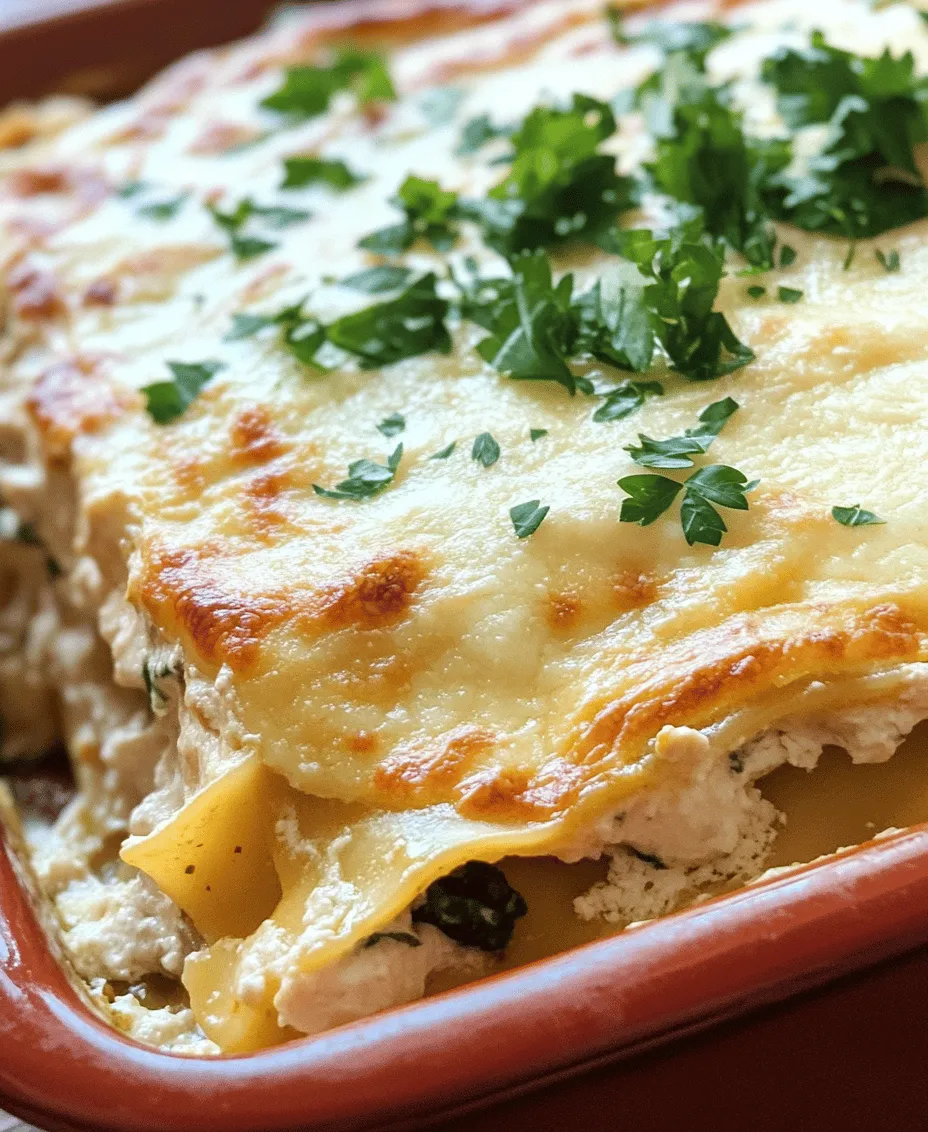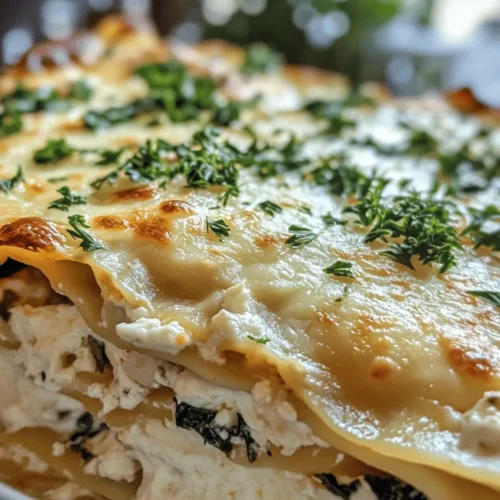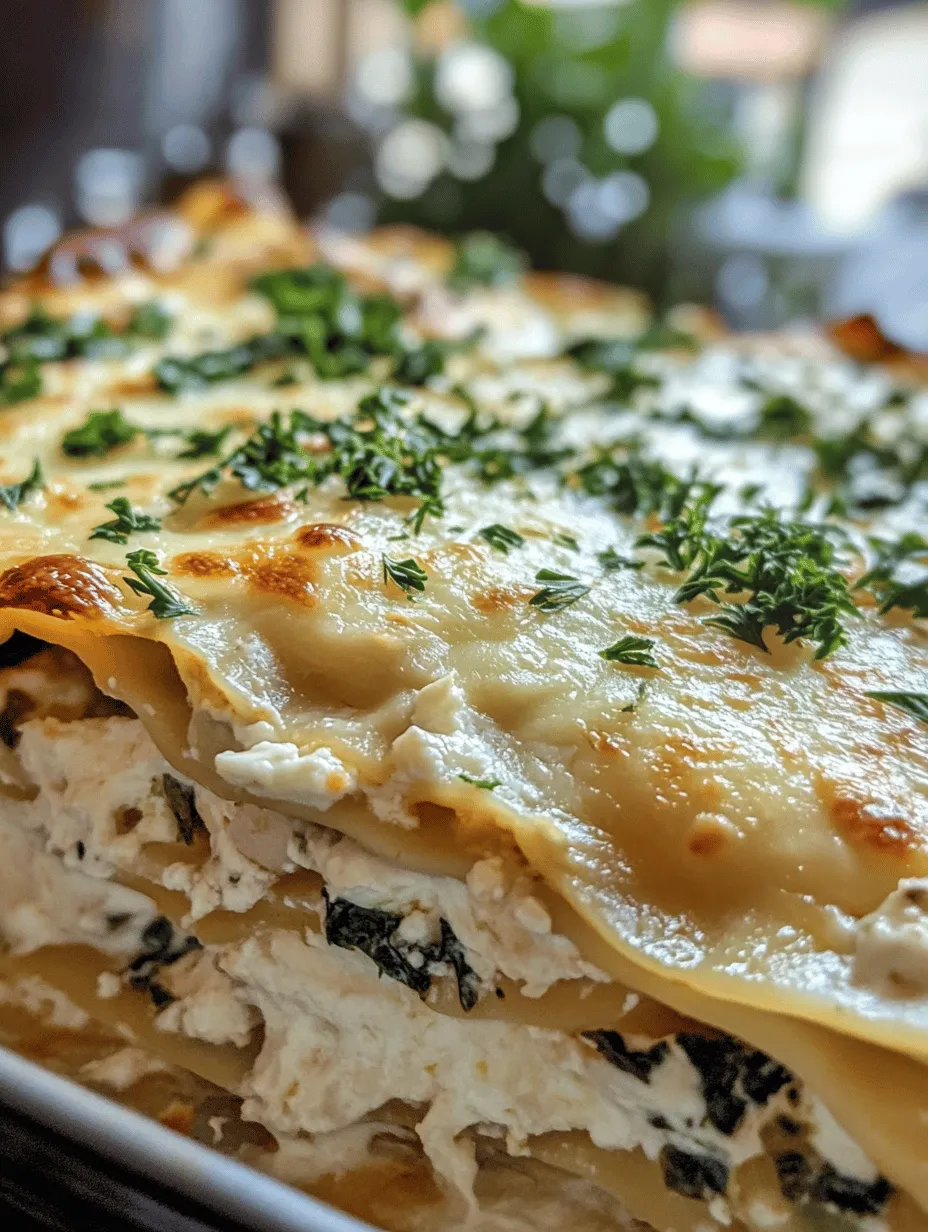Lasagna is a dish that has captured the hearts of many, serving as a symbol of comfort and warmth in kitchens around the world. This particular recipe for Creamy Chicken Lasagna with White Sauce elevates the traditional Italian dish into a realm of creamy decadence, making it a standout option for both casual family dinners and festive gatherings. By replacing the classic meat sauce with tender, shredded chicken enveloped in a velvety white sauce, this lasagna offers a delightful twist that is sure to impress your guests.
The beauty of this recipe lies in its simplicity. While it may seem daunting at first glance, the preparation is straightforward, allowing you to create a restaurant-quality meal in the comfort of your own home. With layers of pasta, chicken, and rich white sauce, each bite offers a medley of flavors that harmonize beautifully. Whether you are a seasoned cook or a beginner in the kitchen, this creamy chicken lasagna is accessible and rewarding.
In this article, you will find a comprehensive exploration of the ingredients and preparation steps, ensuring you are well-equipped to recreate this delicious dish. From understanding the role of each component to tips for successful assembly, we will guide you through the process of crafting a lasagna that is not only delicious but also visually stunning.
Understanding the Ingredients
To master the art of making Creamy Chicken Lasagna, it is essential to familiarize yourself with the core ingredients that contribute to its unique flavor and texture. Each component plays a vital role in creating the harmonious blend that defines this dish.
Overview of Lasagna Noodles
Lasagna noodles are the backbone of this dish, providing structure and holding together the layers of filling. Traditionally, lasagna is made with flat, wide noodles that are either fresh or dried. While both types work well, fresh noodles tend to yield a softer, more delicate texture. If you choose to use dried noodles, opt for no-boil varieties; they often require less prep time and absorb moisture from the sauce during baking. Regardless of your choice, ensure that your noodles are cooked al dente to maintain their structural integrity and prevent them from becoming mushy in the final product.
The Role of Shredded Chicken
In this creamy version of lasagna, shredded chicken takes center stage as the primary protein source. Chicken breast is a popular choice due to its mild flavor and lean profile. When cooked and shredded, it seamlessly integrates with the white sauce, adding a hearty yet tender texture to each layer. For convenience, you can use store-bought rotisserie chicken, which saves time and effort while still delivering great flavor. If you prefer to cook your chicken from scratch, poach or bake it before shredding to retain moisture and ensure maximum tenderness.
Importance of Cheese Blends: Ricotta, Mozzarella, and Parmesan
Cheese is a crucial element in any lasagna, and this recipe features a harmonious blend of ricotta, mozzarella, and parmesan. Ricotta cheese adds a creamy richness and helps bind the layers together. It also brings a subtle sweetness that complements the savory chicken and white sauce beautifully. Mozzarella cheese contributes that signature melty texture we all love, while parmesan adds a sharp, nutty flavor that enhances the overall taste profile. Combining these cheeses creates a delightful balance of creaminess and flavor, ensuring that each bite is indulgent.
Nutritional Benefits of Fresh Spinach
Fresh spinach not only adds a pop of color to your lasagna but also infuses it with nutritional benefits. Packed with vitamins A, C, and K, spinach is a powerhouse of nutrients that contributes to overall health. Additionally, it contains iron and calcium, making it a great addition to your meal. When cooked, spinach wilts down significantly, allowing you to incorporate a generous amount into the filling without overwhelming the dish. Its mild flavor pairs well with the other ingredients, making it a perfect complement to the creamy chicken lasagna.
Flavor Enhancers: Garlic and Onion Powder, Dried Basil
To elevate the flavors of your creamy chicken lasagna, incorporating herbs and spices is essential. Garlic and onion powder provide a savory foundation that enhances the overall taste without overpowering the dish. Dried basil is another key ingredient that infuses the lasagna with a warm, aromatic essence reminiscent of traditional Italian cuisine. Together, these flavor enhancers work to create a well-rounded dish that is both comforting and satisfying.
Preparing Your Kitchen for Lasagna Making
Before diving into the cooking process, it’s important to ensure your kitchen is well-equipped and organized. Proper preparation will streamline your cooking experience and help you achieve the best results.
Essential Kitchen Tools and Equipment
To make your creamy chicken lasagna, you will need a few essential tools and pieces of cookware:
– Pots and Pans: A large pot for boiling lasagna noodles and a medium saucepan for preparing the white sauce are crucial. A 9×13-inch baking dish is ideal for assembling and baking the lasagna.
– Utensils for Efficient Cooking: A whisk is essential for stirring the white sauce and ensuring a smooth consistency. A spatula will help you layer the ingredients evenly, while mixing bowls are useful for preparing the filling and combining the cheeses.
Importance of Measuring Ingredients Accurately
Accurate measurement of ingredients is vital for the success of your lasagna. Using the correct ratios of chicken, cheese, sauce, and noodles will ensure a balanced flavor and texture. Invest in a set of measuring cups and spoons to help you accurately portion each ingredient. Taking the time to prepare and measure everything before you start cooking will make the process smoother and more enjoyable.
Step-by-Step Guide to Creamy Chicken Lasagna
As we embark on the journey of creating this creamy chicken lasagna, let’s start with the first essential steps: cooking the lasagna noodles and preparing the white sauce. These foundational tasks are crucial to setting up the layers of flavor that will define your dish.
Cooking the Lasagna Noodles
The first step in the lasagna-making process is cooking the noodles.
Tips for Perfectly Cooking Lasagna Noodles
1. Use Plenty of Water: Fill a large pot with water and bring it to a rolling boil. Adding salt to the water enhances the flavor of the noodles as they cook.
2. Follow Package Instructions: Different types of lasagna noodles have varying cooking times, so be sure to follow the instructions on the package. If using traditional noodles, aim for an al dente texture, which means they should be cooked through but still firm to the bite.
3. Stir Occasionally: Stir the noodles occasionally to prevent them from sticking together. This ensures even cooking and allows for proper separation.
Importance of Al Dente Texture
Cooking the noodles to an al dente texture is crucial. If overcooked, the noodles can become mushy, leading to a lasagna that falls apart when served. Al dente noodles will hold their shape and provide the perfect structural support for the layers of creamy chicken, cheese, and sauce.
Creating the White Sauce
The white sauce, or béchamel, is a rich and creamy base that binds the layers of the lasagna together.
Detailed Steps for Preparing the Sauce
1. Melt Butter: In a medium saucepan, melt butter over medium heat until it bubbles gently.
2. Add Flour: Whisk in all-purpose flour, stirring constantly for 1-2 minutes to create a roux. This process helps eliminate the raw flour taste.
3. Incorporate Milk: Gradually whisk in milk, ensuring there are no lumps. Continue to whisk until the mixture thickens and comes to a simmer.
4. Season the Sauce: Stir in salt, pepper, and a pinch of nutmeg for added flavor. Allow the sauce to simmer for a few more minutes until it reaches a creamy consistency.
Tips for Avoiding Lumps in the Sauce
To achieve a smooth white sauce, ensure that the milk is at room temperature before adding it to the roux. Whisk continuously as you incorporate the milk, and avoid adding too much at once to prevent lumps from forming. If lumps do appear, you can use an immersion blender to smooth out the sauce before continuing.
Balancing Flavors: Seasoning Techniques
Taste your white sauce as you prepare it, adjusting the seasoning as needed. A well-seasoned sauce enhances the overall flavor of the lasagna. Consider adding garlic powder or dried herbs at this stage for an extra layer of depth.
Mixing the Chicken Filling
Now that the noodles are cooked, and the white sauce is ready, it’s time to prepare the chicken filling.
Combining Ingredients for the Perfect Filling
In a mixing bowl, combine shredded chicken, ricotta cheese, fresh spinach, and a sprinkle of mozzarella. Ensure that the ingredients are well incorporated, and taste the mixture to check for seasoning. If desired, you can add more herbs or spices at this stage to enhance the flavor profile.
Adjusting Seasonings to Taste
Don’t hesitate to personalize your filling according to your preferences. If you enjoy a bit of heat, consider adding red pepper flakes. For a more herbaceous flavor, fresh basil or parsley can be excellent additions. The beauty of this creamy chicken lasagna is its versatility, allowing you to customize it to suit your palate.
With the noodles cooked, the white sauce prepared, and the chicken filling mixed, you are well on your way to assembling a delicious creamy chicken lasagna that is sure to become a favorite in your household. Stay tuned for the next steps as we layer everything together and bring this comforting dish to life!

Assembling the Lasagna
When it comes to assembling your creamy chicken lasagna, the layering technique plays a crucial role in ensuring optimal flavor distribution throughout the dish. Start by spreading a thin layer of the white sauce at the bottom of your baking dish. This not only prevents the noodles from sticking but also adds an immediate burst of flavor to the base.
Layering Techniques for Optimal Flavor Distribution
1. First Layer: Begin with a layer of lasagna noodles, ensuring they cover the base entirely. You can either use traditional lasagna sheets or no-boil noodles depending on your preference.
2. Second Layer: Spoon a portion of the creamy white sauce over the noodles. Use enough sauce to coat the noodles while maintaining a balanced ratio to the other layers.
3. Third Layer: Add a generous portion of the shredded chicken. Here’s where you can also sprinkle some sautéed spinach or mushrooms if desired for added flavor and nutrition.
4. Fourth Layer: Sprinkle a layer of mozzarella cheese over the chicken. This will melt beautifully during baking and create a deliciously stretchy texture.
5. Repeat: Continue layering in this manner – noodles, white sauce, chicken, and cheese – until you reach the top of the baking dish. Aim for at least three layers for a satisfying bite.
6. Final Layer: For the topmost layer, finish with a layer of noodles covered by the white sauce and a generous sprinkle of mozzarella cheese. This final touch will create a beautifully golden and bubbly topping when baked.
Baking the Lasagna
Once your lasagna is assembled, it’s time to bake it to perfection. This step is essential for melding the flavors together and allowing the cheese to achieve that coveted golden-brown crust.
Importance of Covering with Foil
Before placing your lasagna in the oven, cover the baking dish tightly with aluminum foil. This helps to retain moisture during the initial baking period, preventing the top from burning before the inside is fully cooked. To ensure the foil doesn’t stick to the cheese, you can either spray it lightly with cooking spray or use a piece of parchment paper between the foil and the cheese.
Monitoring Cooking Time for a Perfect Finish
Bake the lasagna in a preheated oven at 375°F (190°C) for about 30-40 minutes covered with foil. After this time, carefully remove the foil and bake for an additional 10-15 minutes. Keep an eye on it; you want the cheese to be bubbling and golden brown without burning. Once done, let the lasagna rest for about 10-15 minutes before slicing. This resting time allows the layers to set and makes serving much easier.
Serving Suggestions for Creamy Chicken Lasagna
Creamy chicken lasagna is a versatile dish that pairs beautifully with various sides. Here are some recommendations to elevate your meal.
Ideal Pairings: Sides and Salads
– Fresh Green Salad Recommendations: A crisp salad can balance out the creaminess of the lasagna. Consider a simple arugula salad dressed with lemon vinaigrette for a refreshing contrast. Alternatively, a Caesar salad with crunchy romaine and homemade croutons complements the richness of the lasagna beautifully.
– Garlic Bread Pairing for Extra Flavor: Don’t overlook the classic garlic bread! The crunchy, buttery slices are perfect for mopping up any remaining sauce on your plate. To make it, simply spread a mixture of softened butter, minced garlic, and parsley on slices of French bread and toast them until golden.
Garnishing and Presentation
– Creative Garnishing Ideas: For a delightful presentation, consider garnishing your lasagna with fresh basil leaves or a sprinkle of grated Parmesan cheese. This not only adds visual appeal but also enhances the overall flavor profile.
– Tips for Serving and Enjoying: When serving, use a sharp knife to slice through the layers cleanly, ensuring each piece holds its shape. Serve with a side of your favorite red or white wine to further enhance the dining experience.
Nutritional Analysis of Creamy Chicken Lasagna
Understanding the nutritional value of your meal is important, especially if you’re mindful of dietary choices. Here’s a breakdown of what you can expect from a serving of creamy chicken lasagna.
Breaking Down the Nutritional Value
– Caloric Content per Serving: A typical serving of creamy chicken lasagna contains approximately 400-500 calories, depending on the portion size and specific ingredients used.
– Macronutrient Composition: Proteins, Fats, and Carbohydrates: Each serving is well-balanced, typically offering around 30 grams of protein, 20 grams of fat, and 40 grams of carbohydrates. This composition makes it a hearty meal that can keep you satisfied for hours.
– Benefits of Using Fresh Ingredients: By using fresh chicken, vegetables, and homemade white sauce, you can drastically improve the nutritional profile of your lasagna. Fresh ingredients are generally more nutrient-dense and free from preservatives that can be found in many pre-packaged alternatives.
Exploring Variations of Creamy Chicken Lasagna
One of the best aspects of creamy chicken lasagna is its versatility. You can easily customize it to suit your tastes or dietary restrictions.
Customizing Your Lasagna Recipe
– Substituting Ingredients for Dietary Restrictions: If you’re looking for a gluten-free option, consider using gluten-free lasagna noodles. For those with dairy allergies, there are plenty of plant-based cheese alternatives available that melt well.
– Exploring Different Cheese Combinations: While mozzarella and ricotta are classic choices, experimenting with cheeses can elevate your dish. Try adding provolone for a sharp flavor or a sprinkle of feta for a tangy twist.
– Adding Vegetables for Extra Nutrition: Incorporating vegetables like zucchini, bell peppers, or carrots not only boosts the nutritional content but also adds color and texture to your lasagna. Sauté vegetables before layering them in to enhance their flavors.
Conclusion: The Joy of Making Creamy Chicken Lasagna
Creamy chicken lasagna with white sauce is more than just a meal; it’s an experience that brings warmth and comfort to the dining table. With its layers of flavor, rich textures, and customizable nature, this dish is sure to become a beloved staple in your home. Whether you’re sharing it with family or enjoying a cozy night in, this lasagna promises to satisfy your cravings and leave you wanting more. Embrace the joy of cooking, and let this delightful recipe inspire your next culinary adventure. Now is the perfect time to gather your ingredients and create your own version of this creamy, comforting classic!



